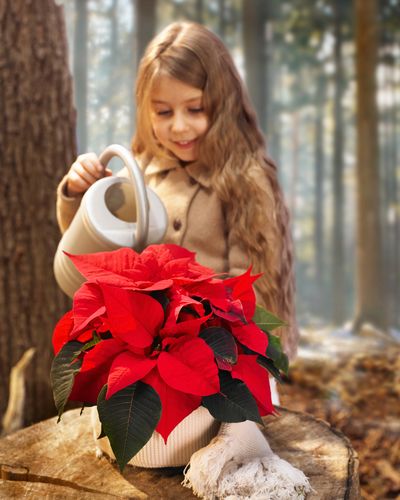Watering poinsettias right: from above, from below or by immersing in water
Poinsettias can be watered in various ways. Classically watering from the top is probably the most common. Here it is essential to only water when the upper layer of substrate has dried to a depth of about 2 centimetres. But be careful: The roots in the centre of the pot should never be allowed to dry out. The water should be supplied gradually until the root bale is uniformly moistened but not soaked. “A rule of thumb is that the amount of lukewarm water given a house plant should be about 10 percent of the volume of its container.” “That makes 70 to 90 ml for a poinsettia in a 12-cm pot and 100 to 130 ml for a 14-cm pot.” Important: As soon as water seeps out the drainage hole you should stop watering. Remove any excess water in the saucer no more than 15 minutes later.
Professionals breeders rely on the so-called sub-irrigation method for cultivating these Christmas messengers. For this, the cultivation tables in the greenhouses are flooded for about 15 minutes every day up to a level of a few centimetres. This gives the plants the opportunity to soak up the amount of water they need. This professional method can be imitated at home by adding lukewarm water to the saucer for 15 minutes every day or every two or three days, depending on the location and plant size. Then the excess water is removed. Please note: With this watering method, the water is soaked up into the substrate from below, causing the surface of the soil to often become quite dry even if there is still adequate moisture in the root bale. The easiest way to determine if watering is necessary is by feeling the weight. Bottom watering is particularly gentle for sensitive roots.
An alternative to regularly watering is immersion of the plant in water, which should be done about once or twice a week, depending on the size of the plant, ambient temperature and location. “The nearly dry root bale is fully immersed in room-temperature water for a few minutes. This works best in a vase or a larger pot. You can tell by the bubbles that the plant is absorbing the water. As soon as the bubbling subsides, the poinsettia has had enough and the plant should be lifted out immediately, to allow excess water to drain, and put back in its pot.” No surplus of water should remain in the pot, which makes it crucial to check the pot after approx. 15 minutes and drain off any water that has leaked out.
A matter of taste
Regardless of which of the three methods is chosen, the important thing is avoiding too much and too little moisture. The immersion method is best for plant owners who don’t have much time for plant care or who are away a lot. It has the advantage that you can go away for a few days without having to worry about coming back to find a parched poinsettia. However, those who like pottering with their plants will probably prefer either of the first methods described here.
Tip: Poinsettia miniatures must be watered at room temperature every day, as they only have a small amount of soil available as a water reservoir. For this reason, these small stars react more quickly to dry conditions. Even dry indoor air can be a problem for them.
The result: The leaves develop brown tips or drop off. Therefore, miniatures should not be placed too close to radiators and other heaters.
Tip: Fallen or yellowed leaves are a sign that a poinsettia has been overwatered. In this case the substrate should be allowed to dry out completely before watering again. With a bit of luck the plant will recover.
Further information and additional pictures are available in a free download at archiv.stars-for-europe.com.
Reprint free of charge with reference to the “Stars for Europe” image source, specimen copy requested.
